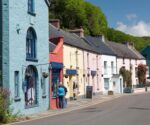I visited the UK’s ‘most underrated beach’ – I’m not sure I’d go back | UK | Travel
In the farthest reaches of the UK, miles away from the nearest Greggs, lies the nation’s most underrated beach.
The Outer Hebrides may not boast a single branch of the popular sausage roll chain, but it is home to Garry Beach. This hidden gem is nestled on Lewis, the largest of the Western Isles.
Garry Beach has recently been crowned the most underrated beach in the UK by Boat Booker. The firm analysed Google Maps beaches labelled as “secluded” and “secret,” ranking those with fewer than 100 reviews.
They highlighted coastal spots boasting pristine waters and dramatic landscapes that remain relatively unexplored.
Scotland dominates the rankings, claiming six spots in the top 10. Islands such as Mull and Barra feature prominently, reports The Mirror.
Porth Trwyn in Wales is the highest-ranked non-Scottish beach, coming in fourth place.
It’s easy to see why the Hebridean coastline might be underrated, given its remote location and challenging accessibility. This is particularly true for Garry Beach.
My journey to the Isle of Lewis involved two days, approximately eight hours of driving, a three-hour ferry ride, and a five-hour train journey, followed by another hour on the road north of Stornoway to reach Garry Beach. I undertook this epic trip in a robust Range Rover kindly loaned by Turo rental car.
If the 668-mile journey from London to Stornoway doesn’t deter you, then the 15 miles from Stornoway to Garry Beach might. It could arguably be one of the most monotonous and desolate stretches of countryside in the UK.
My Swedish in-laws, seated comfortably in the back of our spacious Sport 2020, couldn’t help but comment on the bleakness of our destination. However, upon arrival, the less appealing roads of North Lewis were quickly forgotten in favour of the lovely beach.
A small car park, capable of accommodating around five vehicles, was conveniently located just a two-minute stroll from the water’s edge. From there, we meandered over a grassy mound onto the sandy bay, which extends several hundred metres in both directions.
Much like many of the more secluded Scottish beaches – especially the sandy ones found in the Hebrides and Shetland – the water is an astonishing blue. It’s as if it’s been scooped up by a fire-fighting plane from a rum advert shot in the Caribbean and dumped thousands of miles away for the enjoyment of a few dog walkers and a solitary fisherman.
The beach is situated on the eastern edge of Lewis, meaning it doesn’t experience the dramatic waves and salty spray of the island’s Atlantic coast. Things are somewhat calmer here.
Instead of crashing into a froth, waves gently lap around the fascinating rock formations that protrude from the sand. Several have been eroded to form excellent climbing platforms and archways into the surf.
Despite its beauty, Garry Beach has one significant drawback: the weather. This, coupled with the fact that the Isle of Lewis is miles away from all but the 20,000 or so residents, presents a challenge.
The highest temperature ever recorded on Lewis was a mere 26.3 °C, back in 1999. Unless you’re incredibly fortunate, this beach demands a sturdy raincoat and the resilience to endure Hebridean gales.
In the peak season of July, sun worshippers can anticipate 12 days of rainfall and temperatures reaching average highs of just 16C. That’s a chilly 7C cooler than the southern coast of England.
Unless you’re made of particularly tough stuff, this isn’t a beach for lounging on the sand for hours or splashing about in the waves. It’s a beach that marries the stunning and the stark aspects of the British Isles’ coastline in a way few other places can.
If Garry’s offering sounds appealing but the lengthy journey is off-putting, there are some slightly closer alternatives. One of my personal favourites is Sandaig, a beach a few miles from the picturesque Scottish village of Glenelg.
This tranquil spot was immortalised as Camusfearna in ‘Ring of Bright Water’, a book penned by Gavin Maxwell about his life living with pet otters.
Not only is the water crystal clear and very inviting for those who can withstand the intense cold of a Scottish sea loch, winding paths lined with small bushes and trees run between rugged rock towers, creating the perfect setting for a game of Flags or 40:40. If the weather does turn, there’s plenty of driftwood scattered around that can be used to warm a chilled party huddled in one of Sandaig’s natural rock alcoves.








